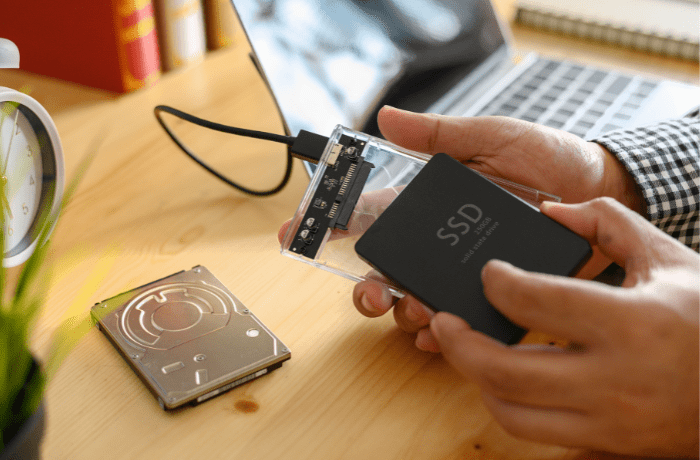In the past, computers were equipped with magnetic hard disks. Now, they usually come with solid state drives (SSD) – which have a number of benefits over the older option.
After all, SSDs are built to be more durable and stable than conventional hard disks.
Furthermore, as they have no moving parts, they are much more adaptable to changes in temperature and are very resistant.
The most noticeable difference is the absolute speed gain of the SSD over the hard disk, including a much faster boot-up.
However, some situations cause Windows not to recognize the SSD, which stops it from booting.
The good news is that the problem can usually be solved – as we will show you in our article today.

Why is the SSD not recognized?
Here are the main reasons why Windows doesn’t recognize your SSD, check them out:
New SSD that hasn’t been initialized yet
If you bought a new SSD and it doesn’t show up in Windows Explorer, it is probably in an “uninitialized” state.
In this case, you must initialize the disk before Logical Disk Manager can access it.
Also, if an old SSD shows the “unknown disk not initialized” error, the reason is the same.
Whatever the situation, to fix the problem you should try connecting the SSD to another working computer to see if it reports the same error.
If not, you will need to start the SSD in Windows.
SSD partition drive letter disappears
A common reason why Windows does not recognize an SSD is a conflicting or missing drive letter.
You can solve this problem quickly by changing or assigning a new drive letter to the SSD in Disk Management.
Incorrect connection
You should check the connection to make sure that the SSD is connected correctly.
Check that the cable is pushed in and plugged properly into the port. Make sure it is properly adjusted and also test the cable to make sure it is not damaged.
What to do when the SSD doesn’t recognize it?
Here are 6 solutions you can use when your SSD is not recognized:
Solution 1: Repair defective hardware
Defective SSD hardware can contribute to aggravating the error. This can cause the BIOS not to detect it during boot-up.
Remember that all ports must work properly, with a good connection to the device.
So, if you notice any problems, you can replace the SSD port to check that it works with the BIOS.
Solution 2: change the BIOS settings
To fix the SSD that Windows does not recognize, reconfigure it in the BIOS as follows:
- Restart your computer
- Press the “F2” key
- Press the “Enter” key
- Select “Serial ATA”
- Press “Enter”
- Save your changes to the SATA controller mode option
- Restart the computer to enter the BIOS.
Solution 3: update the SSD drivers
An outdated or missing driver on the device would cause the SSD not to be recognized.
One way to fix this is to update the drivers manually.
To do this, you can visit the manufacturer’s website and find the respective hardware device driver.
Then download the latest version of the driver and run the installation on your device. Remember to download the update compatible with the version of your operating system
Solução 4: inicie o novo drive SSD
To start an SSD, follow these steps:
- Step 1: open “Disk Manager”;
- Step 2: Locate and right-click on the SSD you want to start and click on “Start disk”;
- Step 3: In the “Start Disk” dialog box, select the disk(s) to start. You can select whether you want to use the master boot record (MBR) or GUID partition table (GPT) partition style.
Solution 5: Disk Manager repair
Follow the steps below to repair the SSD that doesn’t appear in Windows with Disk Manager:
- Step 1: go to “Disk Manager”;
- Step 2: check if your SSD volume is RAW;
- Step 3: format the drive, if applicable.
Solution 6: Allocate or change the SSD letter
To allocate/change the drive letter of an SSD:
- Search for “Disk Manager” in the search bar of the “Start” menu, right-click and select “Run as administrator”;
- Right-click on your SSD and select “Change drive letter and path”;
- Click “Add” if the drive letter doesn’t exist, or “Change” to modify the existing drive letter;
- Select the new drive letter from the drop-down menu and click “Ok” for the changes to take place.
After following the steps above, you can restart your PC and Windows will recognize the SSD. You can access the SSD via “File Explorer”.
How do I recover data from an undetected SSD?
If the above solutions cannot fix the SSD that Windows does not recognize, you need to recover the data.
To do this, you can use two alternatives:
- Software: some systems promise to recover data from the SSD, but using them requires technical knowledge and running them incorrectly can cause permanent data loss
- Professional recovery service: by opting for this alternative, you guarantee that your data will be recovered safely, without the risk of further damaging your SSD.
How to avoid an unrecognized SSD in the future?
To avoid the SSD not being recognized in the future, consider the following points:
- Avoid extreme heat: place your SSD notebook on a fresh platform so it won’t overheat;
- Power outages are silent killers of hardware: so connect your PC to a stable power source – like a stabilizer, for example;
- Always leave some free space on your SSD: try not to fill up more than 75% of it;
- Limit how often you write to your SSD: the less you format it or erase data, the longer it will last;
- Finally, remember: defragmentation can consume the life of your SSD.
Conclusion
The SSD has several advantages over traditional disks, but it can suffer a few errors.
One of them is not being recognized by the operating system, which can happen due to a connection failure, lack of letter assignment for the drive or because it hasn’t started up yet.
To solve the problem, you can repair the hardware, change the BIOS settings, update the drivers, boot the drive, use Disk Manager or change/assign a letter to the drive.
To ensure that you don’t lose your files and documents saved on the SSD that the operating system doesn’t recognize, the ideal is to recover the stored data.
You can opt for software for this (which can aggravate the problems on the SSD and not be effective) or ensure proper data recovery through a specialized professional service – like the one we offer here at Bot.
Our highly trained professionals will carefully analyze your SSD to recover your data, without damaging your device.
In addition, we can analyze and quote for your device within 48 hours!
Finally, for your convenience, we can collect your device from any address in Portugal.
Be one of our more than 100,000 successfully resolved cases: start your recovery with us now!


